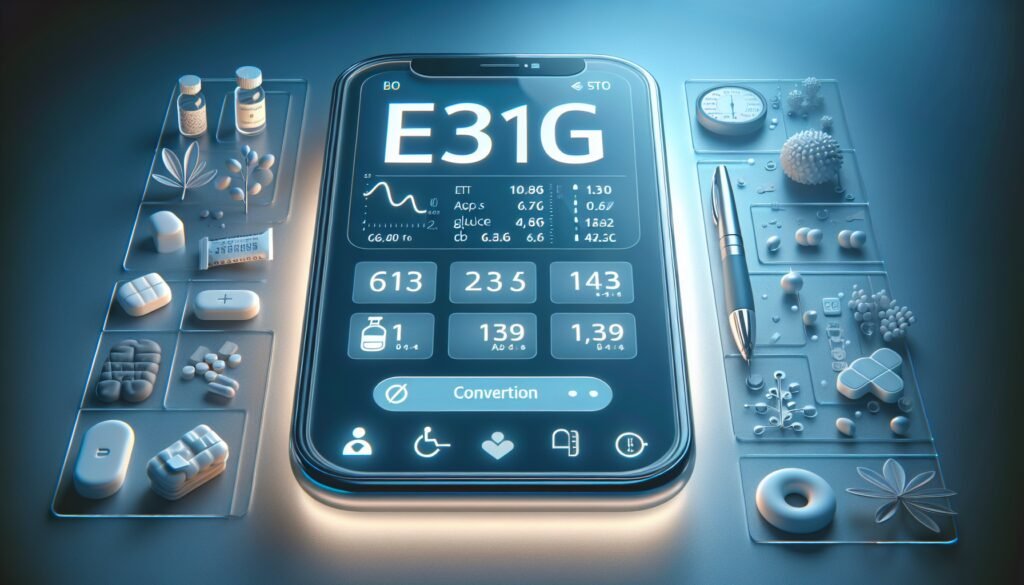
Managing diabetes effectively requires an understanding of various medical terms and measurements that can sometimes seem overwhelming. One such important measurement is the A1C, which gives a picture of average blood glucose control over a period of months. To make sense of these values, the EAG/A1C Conversion Calculator can be an invaluable tool for those looking to convert A1C levels into more familiar daily glucose readings, or in other words, perform an A1C glucose conversion.
Whether you're a patient trying to understand your blood sugar levels or a caregiver assisting in diabetes management, the A1C to eAG conversion can help clarify treatment goals and outcomes. This article will walk you through the significance of these measurements and how to use the conversion calculator effectively.












What you\'ll find in this article?
- What is A1C and why is it important?
- How to use the A1C to eAG conversion calculator
- Understanding A1C and eAG values
- What do your A1C and eAG results mean?
- Tips for managing your A1C levels effectively
- Blood sugar conversion to a1c
- Blood sugar converter to a1c
- Convert blood glucose to a1c
- Frequently asked questions about A1C and eAG
- Understanding Your Blood Sugar Levels: Related Questions
What is A1C and why is it important?
The term A1C refers to glycated hemoglobin, which develops when hemoglobin, a protein within red blood cells that carries oxygen, joins with glucose in the blood. Essentially, it reflects the average blood glucose levels over the past two to three months. The importance of A1C lies in its ability to provide a long-term overview of a person's blood sugar control, which is crucial for managing diabetes.
Monitoring A1C levels helps healthcare providers adjust medications, and it helps patients understand how diet, exercise, and other factors influence their blood glucose. A high A1C level indicates a higher risk of diabetes-related complications, making it essential to keep these numbers within target ranges set by your healthcare professional.
For individuals with diabetes, the American Diabetes Association (ADA) provides guidelines for A1C goals, which are typically less than 7% for most adults. However, more or less stringent glycemic goals may be appropriate for certain individuals.
How to use the A1C to eAG conversion calculator
To use the A1C to eAG conversion calculator, you'll need your most recent A1C test result. By entering this value into the calculator, it will convert A1C to blood glucose estimates, providing you with your average glucose level (eAG) over the last few months. The eAG is presented in the same units (mg/dL or mmol/L) that your daily blood sugar meter readings use, making it easier to understand and track your progress.
Explore our specialized services in diabetes care 🌟.
From personalized diet plans to effective exercise routines, we have what you need to take control of Type 2 Diabetes.
Visit our services page now!
Here's a step-by-step guide on how to calculate a1c from your A1C to eAG:
- Locate the A1C to eAG conversion calculator online.
- Input your latest A1C percentage into the designated field on the calculator.
- Click the 'calculate' button to convert to a1c into eAG.
The result you receive is your estimated average glucose level for the past two to three months, which is essentially an a1c calculation. Remember, this is an estimation and may not reflect daily fluctuations in glucose levels.
Understanding A1C and eAG values
The relationship between A1C and eAG is a direct correlation that can be converted with reliable accuracy thanks to established formulas, enabling an a1c conversion to blood sugar. While your A1C provides a percentage, the eAG translates this into the same readings as your daily glucose monitor, either in mg/dL or mmol/L, depending on your location.
It's important to note that while A1C gives a broader picture, daily blood glucose monitoring is still crucial for managing diabetes on a day-to-day basis. Regular monitoring can help you adjust your diabetes management plan promptly in response to fluctuations.
Generally, the following values are considered as benchmarks:
- A1C level below 5.7% is considered normal.
- A1C levels between 5.7% and 6.4% indicate prediabetes.
- A1C level of 6.5% or higher on two separate tests suggests diabetes.
What do your A1C and eAG results mean?
Interpreting your A1C and eAG results is crucial for understanding your diabetes management and health status. An A1C result within the normal range indicates good blood sugar control and a lower risk of diabetes complications. Conversely, an A1C above the recommended threshold may suggest the need for a change in your diabetes care plan.
It's essential to discuss your results with your healthcare provider as individual targets can vary. They will help interpret the results in the context of your overall diabetes management and health profile.
For instance, a higher eAG might signal the necessity to adjust your medication, diet, or exercise regimen. In contrast, a lower eAG could indicate the risk of hypoglycemia, especially if you're on insulin or certain diabetes medications.
Tips for managing your A1C levels effectively
Effective diabetes management requires a comprehensive approach that includes lifestyle changes and, when necessary, medication. Here are some tips to help you manage your A1C levels effectively:
- Eat a balanced diet with a focus on low glycemic index foods that don't spike blood sugar levels.
- Maintain regular physical activity, which can help improve insulin sensitivity and lower blood sugar levels.
- Monitor your blood glucose levels as recommended by your healthcare provider.
- Adhere to your medication regimen and discuss any concerns with your doctor.
- Keep up with regular healthcare appointments, including A1C testing.
By following these tips and using tools like the EAG/A1C Conversion Calculator, you can take control of your diabetes and maintain good health.
Blood sugar conversion to a1c
Understanding the conversion from blood sugar levels to A1C is essential for managing diabetes effectively. The A1C test reflects your average blood glucose levels over the past two to three months, providing a broader perspective than daily monitoring.
The formula commonly used for converting blood glucose measurements to A1C values is based on the relationship between the two. Generally, an average blood sugar of 154 mg/dL corresponds to an A1C of about 7%, which is a common target for many patients.
It's important to note that individual factors can affect the accuracy of this conversion. For instance, hemoglobin variations due to certain medical conditions can lead to discrepancies between blood glucose readings and A1C results.
Regular monitoring of both blood sugar and A1C levels helps individuals make informed decisions about their diet, exercise, and medication. This dual approach can significantly enhance overall diabetes management.
Blood sugar converter to a1c
Understanding how to convert blood sugar levels to A1C is crucial for managing diabetes effectively. The A1C test provides an average of your blood sugar levels over the past two to three months, helping to assess long-term glucose control. By using a blood sugar converter, individuals can easily see how their daily readings translate into A1C percentages.
Many people wonder how their current blood glucose readings relate to A1C levels. For instance, a blood sugar level of 154 mg/dL typically corresponds to an A1C of about 7%. This conversion is essential for those aiming to maintain their blood sugar levels within a healthy range. Such tools can simplify this process and provide clarity.
Utilizing a blood sugar converter can also aid in setting realistic goals for blood sugar management. By understanding the relationship between daily readings and A1C, individuals can adjust their diets and medication accordingly. This insight empowers users to make informed decisions about their health.
Moreover, keeping track of blood sugar fluctuations is vital for preventing complications related to diabetes. A blood sugar converter not only helps in understanding past readings but also in predicting future A1C outcomes. This predictive capability can be a game-changer in diabetes management.
In summary, a blood sugar converter is an invaluable tool for anyone looking to manage their diabetes effectively. By transforming daily blood sugar levels into A1C readings, individuals can gain a better understanding of their overall health and make necessary adjustments to their treatment plans. This knowledge is key to achieving optimal blood sugar control.
Convert blood glucose to a1c
Understanding how to convert blood glucose to A1C is essential for managing diabetes effectively. The A1C test measures your average blood sugar levels over the past two to three months, providing a broader picture than daily glucose readings. Knowing this conversion helps you assess your overall glucose control.
To convert blood glucose to A1C, various formulas exist, with one common method being the use of a simple formula: A1C = (Blood Glucose + 46.7) / 28.7. This calculation allows individuals to translate their daily blood sugar levels into an A1C percentage, making it easier to understand their long-term glucose management.
It is important to note that individual variations can affect the accuracy of conversion. Factors such as hemoglobin variants, age, and certain medical conditions may lead to discrepancies. Thus, consulting with healthcare professionals is advisable for personalized interpretations of results.
Regular monitoring and conversion of your blood glucose levels to A1C are crucial for making informed decisions about your diabetes care. This helps in adjusting diet, medication, and lifestyle changes as needed to maintain optimal health. Understanding these numbers can empower patients to take control of their diabetes management.
Ultimately, the ability to convert blood glucose to A1C provides valuable insights into your health status. By keeping track of these measurements, you can better communicate with your healthcare team and improve your overall management of diabetes.
Frequently asked questions about A1C and eAG
Understanding A1C and eAG can be complex. Below, we address some frequently asked questions to clarify these important concepts.
How to calculate eAG from A1C?
To calculate eAG from A1C, you can use the formula: ( eAG = (28.7 x A1C) - 46.7 ). However, the simplest way is to use an online EAG/A1C Conversion Calculator, which does the a1c estimator automatically and provides an estimated average glucose level.
Keep in mind that this is an estimation and individual results can vary based on several factors, including variances in red blood cell turnover rates, recent changes in diet or exercise, and the presence of certain hemoglobin variants.
What is a normal hemoglobin A1C with eAG?
A normal hemoglobin A1C level is typically below 5.7%, which usually corresponds to an eAG of less than 117 mg/dL or 6.5 mmol/L. These numbers are considered to be within the normal range for individuals without diabetes, representing a successful a1c conversion to blood glucose.
However, the definition of 'normal' can vary for each person, especially for those with diabetes, and is best determined in consultation with a healthcare provider based on individual health goals and conditions.
What is my A1C if my glucose is 114?
If your average glucose level is 114 mg/dL, your A1C might be approximately 5.6%. To confirm this estimation, it's important to have an A1C test done by a healthcare professional, as this test will give a more precise and reliable measure of your average blood glucose levels over the past two to three months, a process known as a1c calculation.
Regular A1C testing is a key component of diabetes management and should not be replaced by estimations.
Can I calculate my A1C at home?
While you cannot calculate your A1C at home without a test kit, there are A1C home test kits available that can provide an estimate. These kits typically involve pricking your finger to collect a blood sample, which you either test at home or send to a lab. It's worth asking, "can I calculate my a1c from my glucose readings?" With these kits, you can get a reasonable estimate of your A1C levels based on your glucose readings.
For the most accurate reading, however, it's best to have your A1C tested by a healthcare professional in a clinical setting.
To illustrate the importance of these values, take a look at this informative video.
In conclusion, both A1C and eAG are critical indicators in diabetes management. Regular testing, understanding the results, and using tools like the EAG/A1C Conversion Calculator can empower individuals with diabetes to manage their condition effectively.












